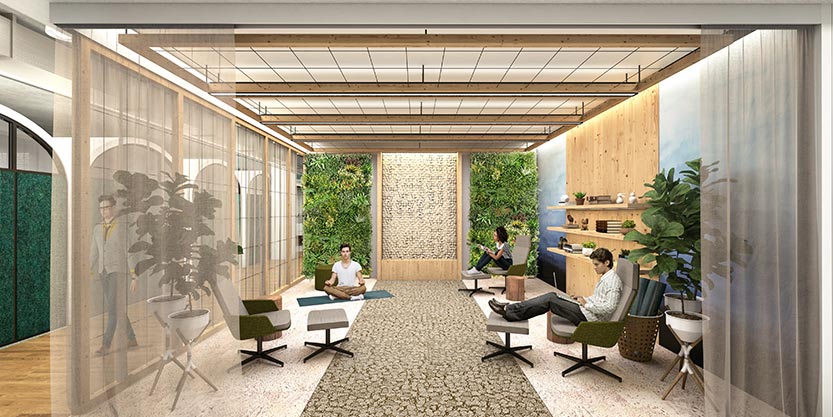Simple design solutions to influence healthy decision-making
Design workplace nudges to support employees’ healthy behavior
The pandemic set off a wellness wake-up call, reminding business leaders that health and well-being programs aren’t just employee perks—they’re vital tools for deepening engagement, averting the Great Resignation and fueling long-term performance. The challenge now is to not only introduce new wellness offerings, but get people to actually use them, too.
Well-intended corporate wellness programs have existed for decades, but stuffy gyms, uninspiring food options and impersonal routines don’t always motivate busy workers to make time to participate. Plus, employees may feel stigma around hitting the gym or meditation room during work hours. According to research in Harvard Business Review, more than half of those who don’t use wellness offerings chalk disengagement up to cultural barriers, including that they don’t feel supported by their employers.
But a little encouragement can go a long way to promoting employee wellness. Offering great amenities is a key first step, but don’t stop there. The following design nudges will help make it easy and intuitive for your teams to engage in healthy options on a day-to-day basis.
1) Make wellness the norm, visibly.
A leader who regularly uses the treadmill or does yoga during lunch is modeling healthy behavior—but only if employees actually see that activity. Design elements can help employees see that their managers actively “walk the walk” when it comes to wellness.
This could be as simple as incorporating more windows and glass partitions, or as complex as positioning stairways centrally in the building’s atrium, as opposed to a design afterthought tucked away for emergency use only. Seeing colleagues and managers engaging in healthy moments easily, and often, can remove stigma and fuel further adoption.
2) Provide automatic wins.
Arranging wellness amenities in strategic locations throughout the space can help make it easier for people to use them. For example, place infused water stations along every corridor to boost hydration, or create rejuvenation spaces on every floor. Or, you might take the opposite route and space out shared amenities, like printers, to prompt people to take a few more steps each day.
3) Incorporate motivating signage.
Want to encourage people to use a workout room, take the stairs or choose a healthy snack over a junky one? Use posters and signs to highlight healthy options, such as labeling a permanent countertop home for a giant bowl of fresh fruit. You can also place signs at each landing in the stairwell to celebrate the distance they’ve just come, or near exterior doors encouraging people to use outdoor terraces and walking areas for walk-and-talk meetings.
4) Celebrate personal wellness.
People may be excited when they surpass their daily step goals. Make that kind of pride something they can share with colleagues using an app as well as a real-life wellness celebration wall. Encourage teams to set shared wellness goals each month, keep a progress chart, and then post victory photos of whomever has reached the goal. Just be sure to focus on the positive achievements, and never guilt anyone for falling behind.
5) Ask what people want—and bring it in to the shared workplace.
The ultimate nudge is one your people are demanding. Use ongoing surveys and listen actively to discover new ways to engage employees in your corporate wellness offerings. For example, you might find demand for nuritionist-led cooking classes, or monthly Ted-Talk-style wellness presentations.
By shaping a wellness-oriented workplace culture based on what employees value, organizations can inspire their teams to feel their best, and in turn bring their best.








